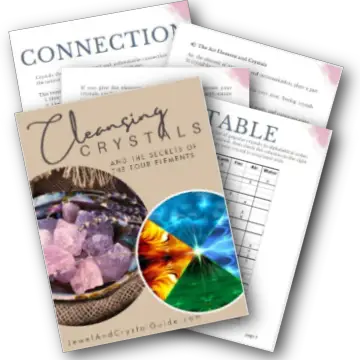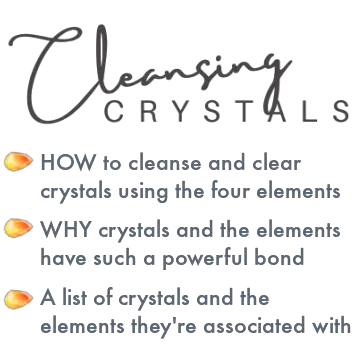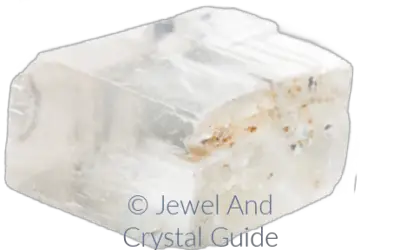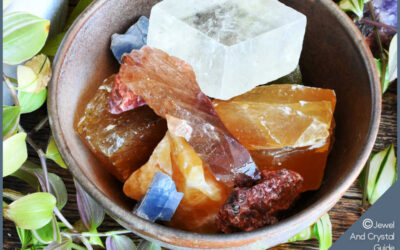Sometimes you just need to know if a piece is natural citrine, heat-treated amethyst, or glass imitation (here’s where I explain the differences between these and what you must know).
There are some things you can do to test or check citrine and decide what it is:
You can tell if citrine is natural by looking at it – genuine citrine is always a shade of yellow, with a fairly consistent color throughout and some transparency. Other ways to test for natural citrine are a density test, a UV light test, and a scratch test.
In this blog post, I’ll share all the methods and ways you can use to check if citrine is real or fake. You need to know that natural citrine shares many properties with heat-treated amethyst, so it can be difficult to tell the difference unless you know what to look for.
While no test is foolproof, doing a few of them will give you the best idea if you’re holding real citrine or something else.
By the end of this post, you’ll have 8 ways to tell if citrine is natural, heat-treated amethyst, or imitation glass.
Test if citrine is real with …
A visual inspection
If you have the citrine, hold it under bright, natural light and look for clues – but you can often tell even in photos if citrine is natural or not.
Here’s what to look for so you can tell natural citrine from heat-treated amethyst and colored glass:
Real or natural citrine has some areas that are more transparent than others, allowing light to pass through the transparent parts. If you hold the crystal against something, you should be able to see objects through it, even if the objects aren’t clear. Heat-treated amethyst is often cloudy or opaque, so you won’t see much or anything through it.
Real citrine has a very pale to a deeper misty yellow color. This color is fairly consistent throughout the crystal, or at least through most of it, with small color variations.
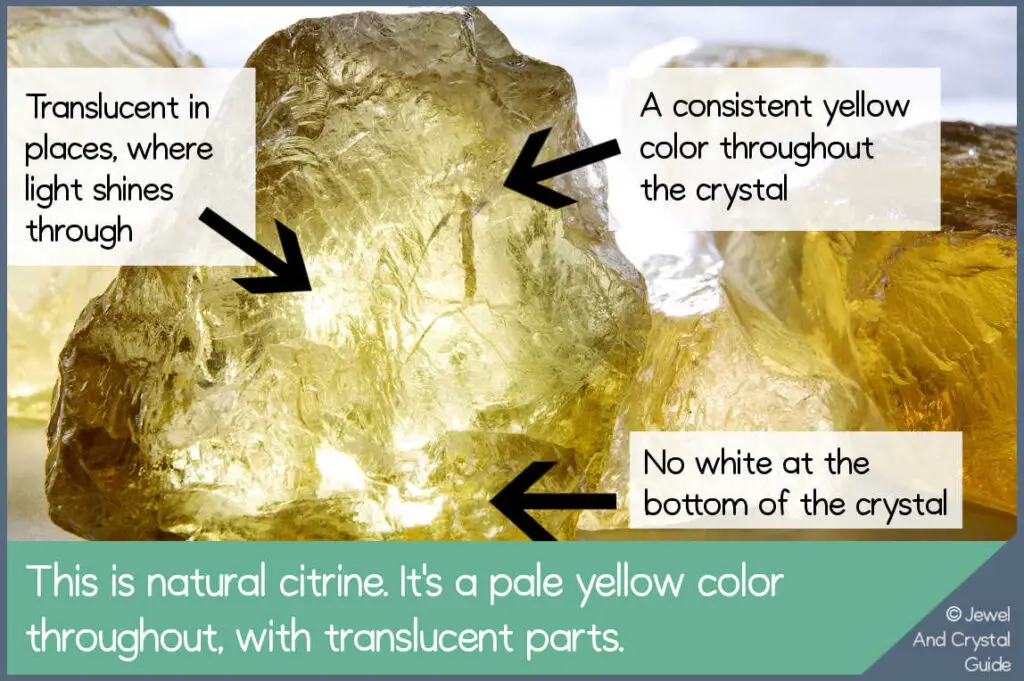
Citrine that isn’t natural often has a vibrant or intense yellow to orange color. This type of citrine is most often heat-treated amethyst, and sometimes colored glass being sold as citrine.
In the case of heat-treated amethyst, you’ll see a more intense almost burnt yellow or orange color on one side of the crystal, where the amethyst was exposed to high heat, and white on the opposite side.
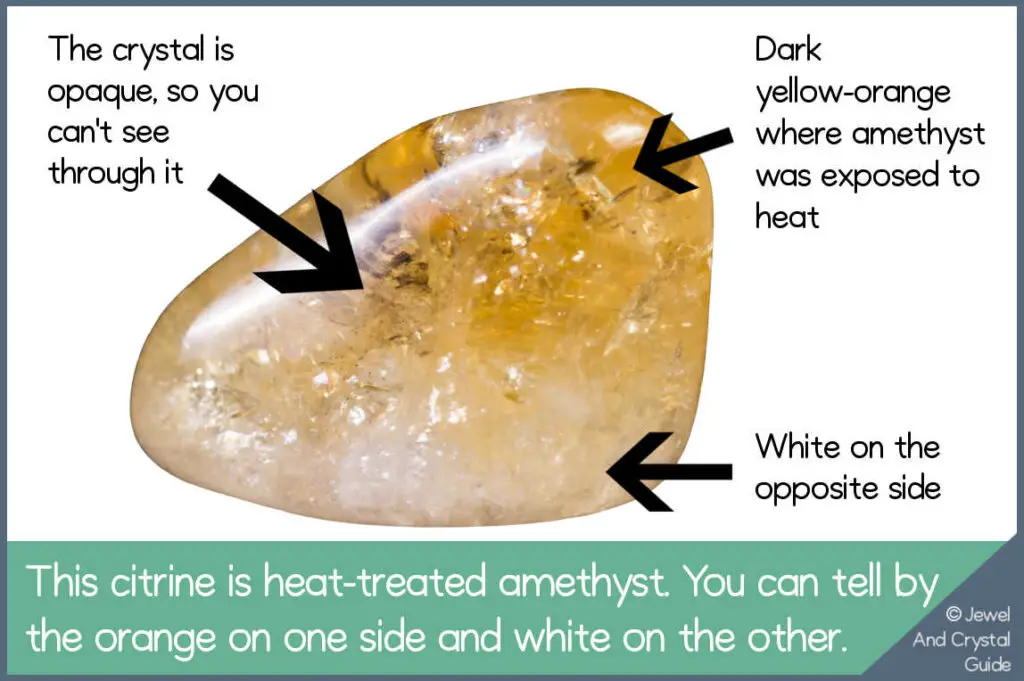
Imitation glass citrine usually has a vibrant yellow color that’s more intense and uniform than natural citrine.

A density test
Citrine has a specific gravity of 2.65 to 2.91 grams, depending on what’s in the crystal.
A fairly accurate way to tell if citrine is real is to measure its specific gravity. Don’t be scared – I’ll show you how!
To get an object’s specific gravity, we measure how much space it takes when we drop it in water.
Here are the steps to calculate the specific gravity of a piece of citrine:
- Weigh a container and write down the weight up to two decimal places. Make sure the container is large enough to hold water and the citrine you are testing.
- Add water to the container and take this measurement, again with two decimal places.
- Put the citrine in the water. Now write down this measurement up to two decimal places.
- Subtract the weight of the empty container from the weight of the water-filled container and the water and citrine weight. You now have the true weights of the water and the water and citrine together.
- Divide the true weight of the citrine and water weight by the true weight of the water-only weight. This gives you the citrine’s specific gravity.
If the specific gravity of the citrine is around 2.65 to 2.91 grams, it falls within the typical range for citrine. Amethyst has the same specific gravity as citrine, so this test won’t tell you if it’s natural citrine or heat-treated amethyst.
If the specific gravity is significantly out of this range, there might be impurities in the citrine or it might be imitation glass (with a specific gravity of around 2.5 grams) or another crystal.
It’s a good idea to use different methods from this blog post to decide if a piece is natural citrine or not.
A floating test
Natural citrine and heat-treated amethyst are denser than water. This means they sink to the bottom or stay suspended in water, without floating along the surface.
But glass imitations usually have a lower density that makes them float in water.
The floating test definitely isn’t a foolproof way to tell if a piece is crystal or glass, but feel free to use it as an additional way to test your piece…
Drop the piece in water and wait to see what happens. If it floats along the top of the water, there’s a good chance you have a glass imitation. If it stays suspended in the water below the surface, or it slowly floats to the bottom of the water, there’s a good chance you have real citrine or heat-treated amethyst.
A UV light test
Use a UV light to get more clues on whether or not your citrine is natural or something else:
1. Get a UV black light from Amazon or a local hardware store.
2. Wait for nightfall, then turn off the lights in a room to make it as dark as possible.
3. Hold the citrine in your hand or put it on a clean, white surface. Shine the UV light onto the crystal from a few inches away.
4. See if the crystal glows under the UV light.
Natural citrine, heat-treated amethyst and imitation glass do NOT glow or fluoresce under UV light. If your crystal does glow, it’s another type of crystal. For example, scapolite, which looks a lot like citrine, glows yellow or orange under UV light.
A scratch test
The Mohs scale measures how hard minerals are. This scale runs from 1 to 10, with 1 being the softest (e.g. talc) and 10 being the hardest (e.g. diamonds).
Items on the Mohs scale are ranked above all the things that are softer than them and below all the things that are harder than them.
Real citrine is a 7 on the Mohs scale, which makes it softer than minerals like topaz and diamonds, but harder than many other minerals. (citrine is often confused for yellow topaz – here are the differences between these crystals).
To tell real citrine from glass imitations, scratch the crystal with a steel nail or a steel knife. If the steel leaves any sort of mark, the crystal is probably fake because quartz crystal is harder than steel. If the steel leaves no mark at all, it could be natural citrine or heat-treated amethyst.
This test works both ways:
Use the crystal to scratch a steel knife. If it leaves a mark then it’s harder than steel and there’s a good chance the crystal is real.
A temperature test
Real citrine is usually cooler than fake citrine made from glass.
To test this out, keep a drinking glass in the same area as the citrine so they both come to room temperature. Place each one on your bottom lip, to see if you can feel a slight difference in temperature.
If the crystal is actually glass, it should feel the same temperature as the drinking glass on your lips because both are made from glass. If the crystal is real, it should feel a little cooler than the drinking glass.
If you can’t feel any difference and you want to be sure, use an infrared thermometer, like this one from Amazon, to measure the surface temperature of each.
Is about the same price, no matter where you buy it
The cost of citrine depends on the quality, color, and size of the piece, as well as how many people want to buy it and how much citrine is available.
Also, there are a limited number of citrine suppliers. These suppliers sell citrine to retailers for about the same price, who sell them on to you and me.
Retailers must sell the citrine for a certain amount to make a profit, which is more than what they paid to their supplier.
So if you find citrine that’s on sale for a price that’s too good to be true (much cheaper than other sellers), there’s a chance it’s fake.
Here is a table with the average price ranges of citrine per gram:
| Quality | Price Range (USD) |
| Low-grade citrine | Less than $5 per gram |
| Medium-grade citrine | $5 – $20 per gram |
| High-grade citrine | $10 – $40 per gram |
Comes from a trustworthy seller
If you buy citrine from a seller you know you can trust, and that seller tells you the citrine is real, then it should be. Most citrine on the market is heat-treated amethyst, so if you aren’t sure and you must know, do your own tests or ask the seller outright.
Some things you can do to make sure the seller can be trusted are:
- Do some research on the seller to look for bad reviews or complaints that other people have made. You can also speak to others or join Facebook groups and ask for recommendations.
- Check the seller’s website to see what information they give and if they look authentic.
- Ask the seller to provide proof on where they got the citrine from.
- Buy citrine jewelry that is certified by the Gemological Institute of America (GIA) or the gem certification body in your country.
Can be confirmed by a professional
If you must know if a specimen is real citrine or not, and none of the above methods have given you a definitive answer, then ask a professional dealer, lapidist, or appraiser to take a look at the citrine.
A professional has the tools, knowledge, and experience to give you a better idea if a piece of citrine is real or not.
Here’s my full guide to citrine, with everything you need to know about this crystal.





